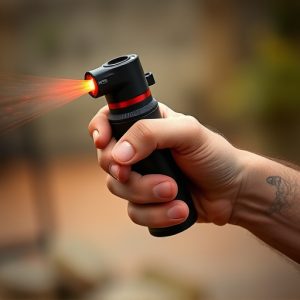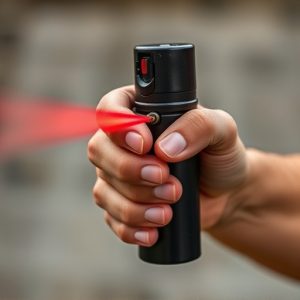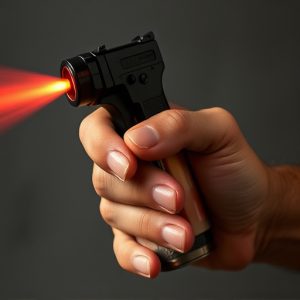Mastering Pepper Spray: Composition, Efficacy, Safety, and Legalities
Maintaining pepper spray's effectiveness requires storing it between 50°F to 70°F (10&d…….
Maintaining pepper spray's effectiveness requires storing it between 50°F to 70°F (10°C to 21°C), protecting it from extreme heat and cold that can degrade its active ingredient, capsaicin. Optimal storage in cool, dry conditions with protection from sunlight and moisture, along with monitoring expiration dates, ensures the spray retains its potency. Following these guidelines, including proper user training and understanding legal regulations, maximizes pepper spray's lifespan and readiness for self-defense.
“Uncover the power of self-defense with a comprehensive guide to civilian pepper spray products. From composition and sensitivity to factors influencing efficacy, this article demystifies the powerful tool. Learn about optimal storage conditions—including the best storage temperature—to ensure longevity, and explore critical safety precautions and legal considerations for responsible ownership. Understand the key elements that make pepper spray an effective deterrent.”
- Understanding Pepper Spray Composition and Sensitivity
- Factors Influencing Pepper Spray Efficacy
- Optimal Storage Conditions for Longevity
- Safety Precautions and User Training
- Legal Considerations and Responsible Ownership
Understanding Pepper Spray Composition and Sensitivity
Pepper spray, a powerful self-defense tool, is comprised of capsaicin, a chemical derived from chili peppers. This compound irritates the eyes and respiratory system, temporarily disabling an assailant. The composition also includes other ingredients like water, alcohol, and thickening agents to ensure effective delivery. Understanding these components is crucial for optimal performance and safety.
Storing pepper spray at the recommended best storage temperature is essential for maintaining its effectiveness. Typically, this ranges between 50°F to 70°F (10°C to 21°C). Exposing it to extreme heat or cold can degrade the active ingredients, reducing its potency. Ensuring proper storage conditions, including keeping it out of direct sunlight and in a cool, dry place, is vital for maximizing the shelf life and reliability of your civilian defense pepper spray product.
Factors Influencing Pepper Spray Efficacy
The effectiveness of pepper spray, a popular civilian defense product, is significantly influenced by several factors. One critical aspect is temperature, specifically the best storage temperature for pepper spray. It’s recommended to store these products in cool and dry conditions, typically between 50-70°F (10-21°C). Exposing pepper spray to extreme heat or cold can compromise its potency, making it less effective when needed. For instance, high temperatures can cause the active ingredients to degrade faster, while freezing conditions may lead to solidification, impacting spray distribution.
Additionally, proper storage involves keeping the spray out of direct sunlight and away from sources of moisture. These environmental factors play a vital role in maintaining the integrity of pepper spray, ensuring it remains potent and ready for use when required. Users should also be mindful of expiration dates, as chemical components can degrade over time, reducing the spray’s effectiveness.
Optimal Storage Conditions for Longevity
To ensure the longevity and optimal performance of your civilian defense pepper spray, proper storage conditions are paramount. The best storage temperature for pepper spray is consistently cool and dry, ideally between 50-70°F (10-21°C). Extreme temperatures can cause the chemical composition of the spray to degrade, reducing its effectiveness over time. Exposing pepper spray to direct sunlight or high humidity levels should be avoided as well, as these conditions can also accelerate its aging process.
In addition to temperature and humidity, it’s crucial to store pepper spray in a secure location, out of reach of children and unauthorized individuals. Keeping the container intact and sealed helps maintain its potency and safety features. A cool, dark pantry or storage closet is usually the best choice for storing your civilian defense pepper spray, ensuring its readiness when you need it most.
Safety Precautions and User Training
When it comes to civilian defense pepper spray, proper safety precautions and user training are paramount. It’s crucial to understand that pepper spray is a powerful tool designed for self-defense purposes, and its effective use requires both knowledge and responsibility. Users should be trained on the correct handling techniques, including how to aim, activate, and store the spray optimally.
One critical aspect of storage, often overlooked but essential, is maintaining the best storage temperature for pepper spray. Ideally, these products should be kept in a cool, dry place with temperatures between 50°F and 70°F (10°C to 21°C). Extreme heat or cold can degrade the spray’s potency and even render it unusable, so proper storage is key to ensuring its effectiveness when needed. Always follow manufacturer guidelines for optimal storage conditions to maximize the life and performance of your pepper spray device.
Legal Considerations and Responsible Ownership
When it comes to civilian defense pepper spray, legal considerations are paramount. Different regions have varying regulations regarding the possession and use of such products. Owning and carrying pepper spray is legal in many places, but restrictions exist on where and how it can be used. For instance, some areas mandate that pepper spray must remain locked away until needed for self-defense. Understanding local laws is crucial to ensure compliance and avoid any legal repercussions.
Responsible ownership involves proper storage and handling of the spray. The best storage temperature for pepper spray is typically between 50°F and 70°F (10°C to 21°C). Extreme temperatures can compromise the integrity of the product, affecting its effectiveness. Moreover, storing it in a cool, dry place helps prolong its shelf life. Responsible owners also keep their sprays out of reach of children and pets and regularly check the expiration date to ensure optimal performance when needed.
Pepper spray is a powerful personal defense tool when used responsibly. To ensure its effectiveness, it’s crucial to understand its composition, store it properly at the best storage temperature of around 50-70°F (10-21°C), and adhere to safety precautions. User training and legal considerations also play vital roles in maximizing its longevity as a personal defense mechanism while avoiding any misuse. By following these guidelines, individuals can make informed decisions about owning and using pepper spray responsibly.


